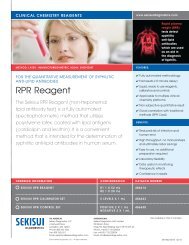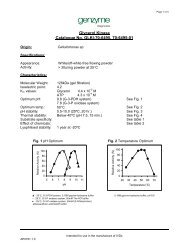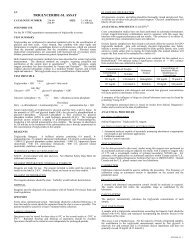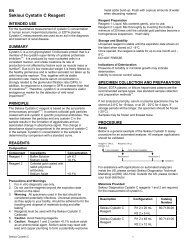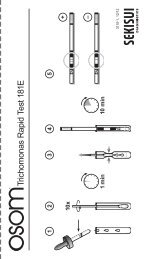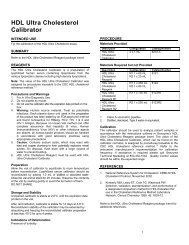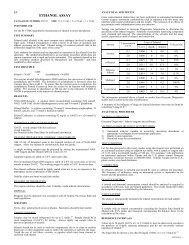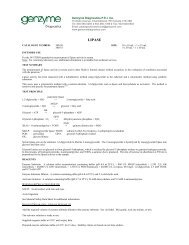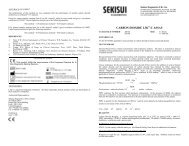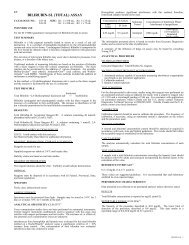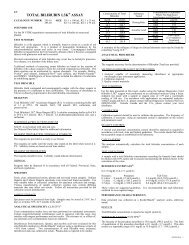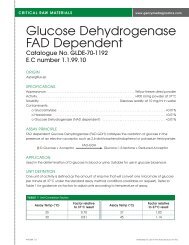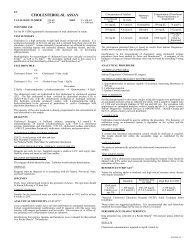ACETAMINOPHEN L3K® ASSAY - Sekisui Diagnostics
ACETAMINOPHEN L3K® ASSAY - Sekisui Diagnostics
ACETAMINOPHEN L3K® ASSAY - Sekisui Diagnostics
Create successful ePaper yourself
Turn your PDF publications into a flip-book with our unique Google optimized e-Paper software.
EN<strong>ACETAMINOPHEN</strong> L3K ® <strong>ASSAY</strong>CATALOGUE NUMBER: 506-10 SIZE: R1: 1 x 10 mL, R2: 2 x 10 mL506-30 R1: 3 x 10 mL, R2: 6 x 10 mLINTENDED USEFor the IN VITRO quantitative measurement of acetaminophen in serum and plasma.Measurement of acetaminophen is used in the diagnosis and treatment ofacetaminophen overdose toxicity.TEST SUMMARYAcetaminophen (paracetamol) is used as an analgesic in many different formulations (1) .While therapeutic doses rarely cause adverse side effects, the effect of long termtreatment with acetaminophen is unclear. Cases have been reported where chronicexcessive use of acetaminophen has led to hepatotoxicity and nephrotoxicity. (2,3) Incases of acute overdosage, acetaminophen can cause severe hepatic damage leading tohepatic failure if untreated. (4,5,6)The management of acetaminophen overdose requires early recognition of the drug inthe bloodstream. Toxicity is generally reported at concentrations over 200 μg/mL (1324μmol/L). N-acetylcysteine has been used as an antidote in conjunction with intensivesupport care. Early diagnosis of acetaminophen-induced hepatotoxicity is importantsince initiation of therapy within 8 hours of ingestion lessens the potential for hepaticinjury, and decreases the mortality rate. (7)The majority of methods for measuring acetaminophen are based on spectrophotometricor chromatographic principles. Chromatographic methods are specific for the parentcompound, however, they are not well suited to emergency laboratories.Spectrophotometric methods are simpler and more rapid, but do not always offer thedesired specificity.This spectrophotometric method is rapid, reliable, convenient, and specific foracetaminophen.TEST PRINCIPLEAcyl AmidohydrolaseAcetaminophen ÿ p-aminophenol + CH 3 COOHMn 2+p-aminophenol + 2,5-dimethylphenol ÿ 4-(4-iminophenol)-2,5-dimethylcyclohexadiene-1-oneThe enzyme, acyl amidohydrolase, cleaves the amide bond of the acetaminophenmolecule, leaving p-aminophenol and acetate. The p-aminophenol is reacted with 2,5-dimethylphenol in the presence of manganese ions to form a colored compound, 4-(4-iminophenol)-2,5-dimethylcyclohexadiene-1-one. The increased absorbance at 605 nmdue to the formation of 4-(4-iminophenol)-2,5-dimethylcyclohexadiene-1-one is directlyproportional to the concentration of acetaminophen in the sample.REAGENTSAcetaminophen Enzyme Reagent (R1): A solution containing buffer (pH 8.6 at 25EC),0.2 mmol/L MnCl 2 C4H 2 O, $ 0.9 KU/L Acyl Amidohydrolase (microbial), 50 mg/Lsodium azide.Acetaminophen Color Reagent (R2): A solution containing 0.1 mol/L sodium carbonatebuffer (pH 11.5 at 25EC), 60 mmol/L 2,5-dimethylphenol, stabilizer, preservative.Acetaminophen Calibrator: 1 x 5 mL of a solution containing buffer (pH 5.0 at 25EC),151 µg/mL (1000 μmol/L) acetaminophen, preservatives.Internal reference standards are created for Acetaminophen using a USP grade referenceAcetaminophen material (not less than 98% and not more than 101% of paracetamol onan anhydrous basis). Acetaminophen calibrator is manufactured gravimetrically andtested against these internal reference standards.WARNINGS AND PRECAUTIONS FOR USER43: May cause sensitization by skin contact. S24/25: Avoid contact with skin andeyes.See Material Safety Data Sheet for additional information.REAGENT PREPARATION, STORAGE AND STABILITYReagents are ready for use.Supplied reagents are stable at 2-8EC until expiry date. Stability claims are based onaccelerated stability studies.REAGENT DETERIORATIONThe reagents should be clear. Turbidity would indicate deterioration.DISPOSALReagents must be disposed of in accordance with all Federal, Provincial, State, andlocal regulations.SPECIMENFresh, clear, unhemolysed serum or lithium heparinized plasma. Specimens should beassayed promptly.LIMITATIONS/ INTERFERING SUBSTANCES (CLSI EP7) (9)Interferences from hemolysis, icterus and lipemia were evaluated for thisacetaminophen method on a Roche/Hitachi ® 717 using a significance criterion of >10% variance from control.Hemoglobin concentration greater than 200 mg/dL (31μmol/L) showed a positive biasof up to 5.0 μg/mL (66 µmol/L) at acetaminophen concentration of 14.0 μg/mL (93µmol/L). Hemoglobin produces significant interference in this method; thereforehemolyzed samples should not be used.Conjugated bilirubin concentration of up to 16 mg/dL (237.6 μmol/L) did not interfere(bias 10% or ±1.25 μg/mL (8 μmol/L) variance from control,whichever is greater. Plasma data is expected to be similar.Substance TestedConcentration with noSignificant InterferenceAcetaminophen levelHemoglobin 200 mg/dL (31 μmol/L)* 14.0 μg/mL (93 μmol/L)*ConjugatedBilirubinUnconjugatedBilirubin16 mg/dL (237.6 μmol/L)* 16.6 μg/mL (110 μmol/L)*40 mg/dL (684 μmol/L) 15.4 μg/mL (102 μmol/L)Ascorbic Acid 3000 μg/dL (170 μmol/L) 15.7 μg/mL (104 μmol/L)N-Acetylcysteine 1500 mg/L (9.2 mmol/L) 14.7 μg/mL (97 μmol/L)Intralipid200 mg/dL [600 mg/dL (6.8mmol/L) SimulatedTriglycerides]*15.3 μg/mL (101 μmol/L)** See additional information under the heading “Limitations/ Interfering Substances”.ANALYTICAL SPECIFICITY TO DRUGSInterferences from the following therapeutic drugs were tested at acetaminophenconcentrations of 4.9 μg/mL (33 μmol/L) and 30.0 μg/mL (199 μmol/L) and wereevaluated for this Acetaminophen method on a Roche/Hitachi ® 717 analyzer using asignificance criterion of >10% or ±1.25 μg/mL (8 μmol/L) variance from control,whichever is greater.Substance TestedTheophyllinePhenylbutazoneIbuprofenImipramineAcetylsalicylic AcidLevodopaAmpicillinDoxycyclineAmitriptylineMetronidazoleCefoxitinCyclosporinMethyl-l-DopaRifampicinSalicylateAscorbic AcidConcentration with No Significant Interference222 μmol/L2.89 mmol/L2425 μmol/L2.5 μmol/L6.51 mmol/L25.3 μmol/L152 μmol/L67.5 μmol/L3.61 μmol/L701 μmol/L1546 μmol/L10.0 μmol/L71 μmol/L78.1 μmol/L4.34 mmol/L342 μmol/LA summary of the influence of drugs on clinical laboratory tests may be found byconsulting Young, D.S. (8)ANALYTICAL PROCEDUREMATERIAL PROVIDEDGenzyme <strong>Diagnostics</strong>’ Acetaminophen reagents and calibrator.MATERIALS REQUIRED (BUT NOT PROVIDED)1. Automated analyzer capable of accurately measuring absorbance at appropriatewavelength as per instrument application.2. Quality control materials.TEST CONDITIONSFor data presented in this insert, studies using Genzyme <strong>Diagnostics</strong> acetaminophenreagent were preformed on an automated analyzer using an endpoint test mode, with asample to reagent ration of 1:41 and a wavelength reading of 660 nm. For assistancewith applications on automated analyzers within Canada and the U.S., please contactGenzyme <strong>Diagnostics</strong> Technical Services at (800)565-0265. Outside Canada and theU.S., please contact your local distributor.CALIBRATIONAn acetaminophen calibrator is included and should be used as directed to calibrate theprocedure. The frequency of calibration on automated systems is dependent on thesystem and the parameters used.QUALITY CONTROLAppropriate concentrations of quality control materials should be analyzed as requiredin accordance with local, state and federal guidelines. The results should fall within theacceptable range as established by the laboratory.(IN50610-4) 1
CALCULATIONSThe analyzer calculates the acetaminophen concentration of each sample.TEST LIMITATIONSA sample with an acetaminophen concentration exceeding the linearity limit should bediluted with 0.9% saline and re-assayed incorporating the dilution factor into thecalculation of the value.REFERENCE INTERVALS (7)Therapeutic concentration: < 30 μg/mL (199 μmol/L)Toxic concentration: > 200 μg/mL (1324 μmol/L)These values are suggested guidelines. It is recommended that each laboratory establishits own expected range.PERFORMANCE CHARACTERISTICSData presented was collected on a Roche/Hitachi ® 717 analyzer unless otherwise stated.RESULTSAcetaminophen concentration is reported as μg/mL (μmol/L).To convert acetaminophen results to mg/L (μg/mL) or mg/dL, use the followingconversion factors:μmol/L x 0.151 = mg/L (μg/mL)mg/dL x 10 = mg/L (μg/mL)NOTE: 1mg/L = 1μg/mLREPORTABLE RANGE (CLSI EP6) (9)The linearity of the procedure described is 377.5 μg/mL (2500 μmol/L). The limit ofquantitation of the procedure described is 0.6 μg/mL (4 μmol/L). This data results in areportable range of 0.6 to 377.5 μg/mL (4 to 2500 μmol/L).PRECISION STUDIES (CLSI EP5) (9)Total precision data was collected on three control sera using a single lot of reagent in40 runs conducted over 20 days. Within run precision data was collected by assayingtwenty samples of three concentrations of control sera in one run using one lot ofreagent.Concentration Total SD Total ConcentrationWithin WithinCVRun SD Runμg/mL μmol/L μg/mL μmol/L % μg/mL μmol/L μg/mL μmol/L CV%10.1 67 0.29 1.9 2.9 10.1 67 0.15 1.0 1.536.7 243 0.47 3.1 1.3 36.2 240 0.29 1.9 0.8112.2 743 1.49 9.9 1.3 110.1 729 0.69 4.6 0.6Additional precision analysis was conducted on two elevated concentrations ofacetaminophen in sera. Total precision was collected over a 10 day period with 4 runsper day with each concentration done in duplicate.ConcentrationTotal SDµg/mL µmol/L µg/mL µmol/LTotal CV%201.5 1334 2.6 17 1.3320.2 2120 4.7 31 1.4ACCURACY (CLSI EP9) (9)The performance of this method (y) was compared with the performance of a similaracetaminophen method (x) on a Roche/Hitachi ® 717. A combination of eighty-eightnatural and spiked patient serum samples ranging from 5.9-377.6 μg/mL (39-2500μmol/L) gave a correlation coefficient of 0.9998. Linear regression analysis gave thefollowing equation:This method = 1.064 (reference method) + 1.1 μg/mL (7.0 μmol/L).The performance of this method with plasma (y) was compared to the performance ofthis method with serum (x) on a Roche/Hitachi ® 717. Twenty-five serum and plasmasamples spiked with acetaminophen ranging from 4.5 to 368.6 μg/mL (30 to 2441μmol/L) gave a correlation coefficient of 0.9999. Linear regression analysis gave thefollowing equation:This method (plasma) = 0.999 [This method (serum)] – 0.3 μg/mL (2.2 μmol/L)TRADEMARKL3K is a registered trademark of Genzyme. All other trademarks, brands,product names are the property of their respective companies.Manufactured by:The AmericasInternationalGenzyme <strong>Diagnostics</strong> P.E.I. Inc. Genzyme <strong>Diagnostics</strong>70 Watts Avenue 50 Gibson DriveCharlottetown, PE C1E 2B9Kings Hill, West MallingCanadaKENT, ME19 4AF, UKPhone: 800-565-0265Fax: 902-628-6504Email: ukdiagcustomerserviceEmail: customerservice@genzyme.com@genzyme.compeidiagnostictechnical@genzyme.comwww.genzymediagnostics.comFRDOSAGE BIOLOGIQUE DEL’ACÉTAMINOPHÈNE L3K ®NUMÉRO DE CATALOGUE : 506-10 FORMAT: R1 : 1 × 10 mL, R2 : 2 × 10 mL506-30 R1 : 3 × 10 mL, R2 : 6 × 10 mLUTILISATION PRÉVUEPour la mesure quantitative IN VITRO de l’acétaminophène dans le sérum et le plasma. Lamesure de l’acétaminophène est utilisée dans le cadre du diagnostic et du traitement de latoxicité liée à des surdosages d’acétaminophène.RÉSUMÉ DES TESTSL’acétaminophène (paracétamol) est utilisé comme analgésique dans plusieurs formulations (1) .Bien que les dosages thérapeutiques causent rarement des effets indésirables, l’effet dutraitement de longue durée à l’acétaminophène n’est pas clairement établi. Dans certains cas,l’usage chronique excessif d’acétaminophène a entraîné l’hépatotoxicité et lanéphrotoxicité (2,3) . En cas de surdosage aigu, l’acétaminophène peut causer des lésionshépatiques graves entraînant une défaillance hépatique si elle n’est pas traitée (4,5,6) .La gestion d’un surdosage d’acétaminophène nécessite que la présence du médicament dans lesang soit décelée tôt. La toxicité est généralement signalée à des concentrations supérieures à200 μg/mL (1 324 μmol/L). La N-acétylcystéine a été utilisée comme antidote conjointementavec des soins de soutien intensifs. Un diagnostic rapide de l’hépatotoxicité causée parl’acétaminophène est important, car le début du traitement dans les 8 heures qui suiventl’ingestion réduit le potentiel de lésions hépatiques et diminue le taux de mortalité (7) .La majorité des méthodes utilisées pour mesurer l’acétaminophène sont basées sur desprincipes spectrophotométriques ou chromatographiques. Les méthodes chromatographiquessont spécifiques pour le composé d’origine; toutefois, elles ne sont pas bien adaptées auxlaboratoires d’urgence. Les méthodes spectrophotométriques sont plus simples et plus rapides,mais ne produisent pas toujours la spécificité souhaitée.Cette méthode spectrophotométrique est rapide, fiable, commode et spécifique àl’acétaminophène.PRINCIPE DU TESTAcyle amidohydrolaseAcétaminophène ÿ p-aminophénol + CH 3 COOHMn 2+p-aminophénol+2,5-xylénol ÿ 4-(4-iminophénol)-2,5-diméthylcyclohexadiène-1-unL’enzyme acyle amidohydrolase divise le lien amide de la molécule d’acétaminophène,laissant du p-aminophénol et de l’acétate. Le p-aminophénol réagit avec le 2,5-xylénol enprésence d’ions de manganèse pour former un composé coloré, 4-(4-iminophénol)-2,5-diméthylcyclohexadiène-1-un. L’absorbance accrue à 605 nm attribuable à la formation de 4-(4-iminophénol)-2,5-diméthylcyclohexadiène-1-un est directement proportionnelle à laconcentration d’acétaminophène dans l’échantillon.RÉACTIFSRéactif enzymatique de l’acétaminophène (R1) : Une solution contenant un tampon (pH 8,6 à25EC), 0,2 mmol/L de MnCl 2 C4H 2 O, $ 0,9 KU/L d’acyle amidohydrolase (microbien), 50mg/L d’azide de sodium.Révélateur de l’acétaminophène (R2) : Une solution contenant 0,1 mol/L de carbonate desodium comme agent tampon (pH 11,5 à 25EC), 60 mmol/L de 2,5-xylénol, un agentstabilisant, un agent de conservation.Calibrateur de l’acétaminophène : 1 × 5 ml d’une solution contenant un tampon (pH 5,0 à25EC), 151 µg/mL (1 000 μmol/L) d’acétaminophène, des agents de conservation.Les normes de référence internes sont créées pour l’acétaminophène au moyend’acétaminophène de référence de qualité USP (pas moins de 98 % et pas plus de 101 % deparacétamol sur une base anhydre). Le calibrateur pour l’acétaminophène a été fabriqué pargravimétrie et testé par rapport à ces normes de référence internes.PRÉCAUTIONS D’EMPLOI ET MISES EN GARDER43 : Peut causer la sensibilisation par le contact avec la peau. S24/25 : Évitez le contact avecla peau et les yeux.Voir la fiche de données de sécurité (Material Safety Data Sheet) pour renseignementssupplémentaires.PRÉPARATION, CONSERVATION ET STABILITÉ DU RÉACTIFLes réactifs sont prêts à être utilisés.Les réactifs utilisés sont stables à une température de 2 à 8 ºC jusqu’à leur date d’expiration.Les affirmations relatives à la stabilité sont basées sur des études de stabilité accélérée.DÉTÉRIORATION DU RÉACTIFLes réactifs doivent être transparents. La turbidité est donc un signe de détérioration.ÉLIMINATIONLes réactifs doivent être éliminés conformément à toutes les réglementations locales,fédérales, provinciales et étatiques.SPÉCIMENSérum frais, transparent, sans hémolyse, ou plasma à héparine de lithium. Les dosagesbiologiques sur les spécimens doivent être effectués dans les plus brefs délais.LIMITES/SUBSTANCES CAUSANT UNE INTERFÉRENCE (CLSI EP7) (9)Les interférences avec l’hémolyse, l’ictère et l’hyperlipidémie ont été évaluées relativement àcette méthode mesurant le taux d’acétaminophène sur l’analyseur Roche/Hitachi ® 717 selonun critère d’importance d’une variance supérieure à 10 % par rapport au contrôle.Une concentration en hémoglobine supérieure à 200 mg/dL (31 μmol/L) a indiqué un biaispositif d’un maximum de 5,0 μg/mL (66 µmol/L) à une concentration en acétaminophène de14,0 μg/mL (93 µmol/L). L’hémoglobine produit une interférence importante dans le cadre decette méthode; les échantillons avec hémolyse ne doivent donc pas être utilisés.Une concentration en bilirubine conjuguée d’un maximum de 16 mg/dL (237,6 μmol/L) n’aproduit aucune interférence (biais inférieur à 10 %) dans des échantillons où la concentrationen acétaminophène s’élevait à 16,6 μg/mL (110 µmol/L). Une concentration en bilirubine(IN50610-4) 2
conjuguée supérieure à 16 mg/dL (237,6 μmol/L) a indiqué un biais positif d’un maximum de13,6 % à une concentration en acétaminophène de 16,6 μg/m L (110 µmol/L).Une concentration en Intralipid supérieure à 200 mg/dL a indiqué un biais positif d’unmaximum de 38 % à une concentration en acétaminophène de 15,3 μg/mL (101 µmol/L). Deséchantillons lipémiques ne doivent pas être utilisés.SPÉCIFICITÉ ANALYTIQUE (CLSI EP7) (9)Aucune étude de contamination croisée n’a été effectuée sur des instruments automatisés.Certaines combinaisons de réactifs ou d’instruments utilisées en séquence dans le cadre duprésent dosage biologique peuvent influer sur le comportement du réactif et les résultats destests. L’existence d’une contamination croisée ou ses effets potentiels ne sont pas connus.L’interférence liée à l’ictère, la lipémie, l’hémolyse, l’acide ascorbique et la N-acétylcystéinea été évaluée pour cette méthode de mesure du taux d’acétaminophène sur l’analyseurHitachi ® 717 au moyen d’un critère d’importance supérieur à 10 % ou d’une variance de±1,25 μg/mL (8 μmol/L) du contrôle, le plus important des deux prévalant. Les donnéesobtenues dans le plasma seront probablement similaires.Substance testéeConcentration sansinterférence importanteNiveau d’acétaminophèneHémoglobine 200 mg/dL (31 μmol/L)* 14,0 μg/mL (93 μmol/L)*Bilirubine conjuguée 16 mg/dL (237,6 μmol/L)* 16,6 μg/mL (110 μmol/L)*Bilirubine nonconjuguée40 mg/dL (684 μmol/L) 15,4 μg/mL (102 μmol/L)Acide ascorbique 3 000 μg/dL (170 μmol/L) 15,7 μg/mL (104 μmol/L)N-acétylcystéine 1 500 mg/L (9,2 mmol/L) 14,7 μg/mL (97 μmol/L)200 mg/dL [600 mg/dLIntralipid (6,8 mmol/L) triglycéridessimulés]*15,3 μg/mL (101 μmol/L)** Se reporter aux renseignements supplémentaires dans la rubrique « Limites/Substancescausant une interférence ».SPÉCIFICITÉ ANALYTIQUE AUX DROGUESL’interférence des drogues thérapeutiques suivantes a été testée à des concentrations enacétaminophène de 4,9 μg/mL (33 μmol/L) et de 30 μg/mL (199 μmol/L) et a été évaluée pourcette méthode de mesure du taux d’acétaminophène sur un analyseur Roche/Hitachi ® 717 aumoyen d’un critère d’importance supérieur à 10 % ou d’une variance de ±1,25 μg/mL(8 μmol/L) par rapport au contrôle, le plus important des deux prévalant.Substance testéeThéophyllinePhénylbutazoneIbuprofèneImipramineAcide acétylsalicyliqueLévodopaAmpicillineDoxycyclineAmitriptylineMétronidazoleCéfoxitineCyclosporineMéthyl-l-DopaRifampicineSalicylateAcide ascorbiqueConcentration sans interférence importante222 μmol/L2,89 mmol/L2 425 μmol/L2,5 μmol/L6,51 mmol/L25,3 μmol/L152 μmol/L67,5 μmol/L3,61 μmol/L701 μmol/L1 546 μmol/L10,0 μmol/L71 μmol/L78,1 μmol/L4,34 mmol/L342 μmol/LUn résumé de l’influence des drogues sur les essais cliniques en laboratoire est disponible enconsultant Young, D.S. (8)PROCÉDURE ANALYTIQUEMATÉRIEL FOURNICalibrateur et réactifs de l’acétaminophène de Genzyme <strong>Diagnostics</strong>.MATÉRIEL REQUIS (MAIS NON FOURNI)1. Analyseur automatisé capable de mesurer précisément l’absorbance à des longueurs d’ondeappropriées, selon l’application de l’instrument.2. Matériel de contrôle de qualité.CONDITIONS DE TESTEn ce qui concerne les données présentées dans cet encart, les études ayant fait appel à ceréactif de l’acétaminophène de Genzyme <strong>Diagnostics</strong> ont été effectuées sur un analyseurautomatisé à l’aide d’un mode d’essai ultime, avec un échantillon dont le rapport avec leréactif est de 1:41 et une lecture de la longueur d’onde de 660 nm. Pour obtenir de l’aide ausujet de l’utilisation des analyseurs automatisés au Canada et aux États-Unis, veuillezcommuniquer avec les services techniques de Genzyme <strong>Diagnostics</strong> au 1-800-565-0265. Àl’extérieur du Canada et des États-Unis, veuillez communiquer avec votre distributeur local.ÉTALONNAGEUn calibrateur d’acétaminophène est compris et doit être utilisé comme prescrit pour effectuerl’étalonnage de la procédure. La fréquence de l’étalonnage sur les systèmes automatisésdépend du système et des paramètres utilisés.CONTRÔLE DE LA QUALITÉDes concentrations appropriées de matériel de contrôle de la qualité doivent être analyséesconformément aux directives locales, provinciales, étatiques et fédérales. Les résultats doiventse situer dans la fourchette acceptable déterminée par le laboratoire.CALCULSL’analyseur calcule automatiquement la concentration en acétaminophène de chaqueéchantillon.LIMITES DES TESTSUn échantillon dont la concentration en acétaminophène dépasse la limite de linéarité devraitêtre dilué dans une solution saline à 0,9 % et faire l’objet d’un autre dosage biologique quiintègre le facteur de dilution dans le calcul de la valeur.INTERVALLES DE RÉFÉRENCE (7)Concentration thérapeutique : < 30 μg/mL (199 μmol/L)Concentration toxique: > 200 μg/mL (1 324 μmol/L)Ces valeurs sont suggérées à titre indicatif. Il est recommandé que chaque laboratoiredétermine sa propre fourchette normale.CARACTÉRISTIQUES LIÉES AU COMPORTEMENTSauf indication contraire, les données présentées ont été recueillies sur un analyseurRoche/Hitachi ® 717.RÉSULTATSLa concentration en acétaminophène est présentée en μg/ml (μmol/L).Pour convertir les résultats relatifs à l’acétaminophène en mg/L (μg/ml) ou en mg/dl, utilisezles facteurs de conversion suivants :μmol/L × 0,151 = mg/L (μg/mL)mg/dL × 10 = mg/L (μg/mL)REMARQUE : 1 mg/L = 1 μg/mLINTERVALLE DE SIGNALEMENT (CLSI EP6) (9)La linéarité de la procédure décrite est de 377,5 μg/mL (2 500 μmol/L). La limite de l’analysequantitative pour la procédure décrite est de 0,6 μg/mL (4 μmol/L). Ces données se situentdans un intervalle de signalement variant entre 0,6 et 377,5 μg/mL (4 et 2 500 μmol/L).ÉTUDES DE PRÉCISION (CLSI EP5) (9)Les données ont été recueillies à partir de trois sérums de contrôle en faisant appel à un lotsimple de réactifs dans le cadre de 40 séries menées sur une période de 20 jours. Les donnéesde précision intra-séries ont été recueillies en effectuant un dosage biologique sur vingtéchantillons de trois concentrations de sérums de contrôle dans le cadre d’une série au moyend’un lot de réactif.Concentration Écart-type total % ConcentrationÉcart-type intrasérieintra-% CVCVμg/mL μmol/L μg/mL μmol/L total μg/mL μmol/L μg/mL μmol/L série10,1 67 0,29 1,9 2,9 10,1 67 0,15 1,0 1,536,7 243 0,47 3,1 1,3 36,2 240 0,29 1,9 0,8112,2 743 1,49 9,9 1,3 110,1 729 0,69 4,6 0,6Une analyse de précision supplémentaire a été effectuée sur deux concentrations élevéesd’acétaminophène dans des sérums. Des données de précision ont été recueillies sur unepériode de 10 jours, avec 4 séries par jour, chaque concentration étant analysée à deuxreprises.ConcentrationÉcart-type totalµg/mL µmol/L µg/mL µmol/L% CV total201,5 1 334 2,6 17 1,3320,2 2 120 4,7 31 1,4PRÉCISION (CLSI EP9) (9)Le comportement de cette méthode (y) a été comparé avec celui d’une autre méthode (x)similaire mesurant le taux d’acétaminophène sur un appareil Roche/Hitachi ® 717. Unecombinaison de quatre-vingt-huit échantillons de sérum naturels et artificiellement traitésprélevés chez des patients, allant de 5,9 à 377,6 μg/mL (de 39 à 2500 μmol/L) a produit uncoefficient de corrélation de 0,9998. Une analyse de régression linéaire a généré l’équationsuivante :Cette méthode = 1,064 (méthode de référence) + 1,1 μg/mL (7,0 μmol/L).Le comportement de cette méthode avec du plasma (y) a été comparé avec le comportementde cette méthode avec du sérum (x) sur une appareil Roche/Hitachi ® 717. Vingt-cinqéchantillons de sérum et de plasma, artificiellement traités à l’acétaminophène allant de 4,5 à368,6 μg/mL (de 30 à 2 441 μmol/L) ont produit un coefficient de corrélation de 0.9999. Uneanalyse de régression linéaire a généré l’équation suivante :Cette méthode (plasma) = 0,999 [cette méthode (sérum)] – 0,3 μg/mL (2,2 μmol/L)MARQUE DE COMMERCEL3K est une marque de commerce déposée de Genzyme. Tous les autres nomscommerciaux, de marques de commerce, de marques et de produits sont la propriétéde leurs propriétaires respectifs.Fabriqué par:Les AmériquesInternationalGenzyme <strong>Diagnostics</strong> P.E.I. Inc. Genzyme <strong>Diagnostics</strong>70, avenue Watts 50 Gibson DriveCharlottetown (Île-du-Prince-Édouard) Kings Hill, West MallingC1E 2B9 CanadaKENT, ME19 4AF, RUTéléphone : 1-800-565-0265Télécopieur: 902-628-6504Courriel: ukdiagcustomerserviceCourriel: customerservice@genzyme.com@genzyme.compeidiagnostictechnical@genzyme.comwww.genzymediagnostics.com(IN50610-4) 3
ESANÁLISIS DE ACETAMINOFENO L3K ®NÚMERO DE CATÁLOGO: 506-10 TAMAÑO: R1: 1 x 10 ml, R2: 2 x 10 ml506-30 R1: 3 x 10 ml, R2: 6 x 10 mlUSO PARA EL QUE FUE DISEÑADOPara la medición cuantitativa IN VITRO de acetaminofeno en suero y en plasma. El análisiscuantitativo del acetaminofeno se emplea para el diagnóstico y tratamiento de toxicidad porsobredosis de acetaminofeno.RESUMEN DEL ANÁLISISEl acetaminofeno (paracetamol) se emplea como analgésico en muchas formulacionesdistintas (1) . Si bien las dosis terapéuticas rara vez producen efectos secundarios adversos, noes claro qué efectos tiene el tratamiento a largo plazo con acetaminofeno. Ha habido casos enlos que el consumo excesivo y crónico de acetaminofeno ha dado lugar a enfermedad hepáticatóxica y a nefrotoxicidad. (2,3) En casos de sobredosis aguda, el acetaminofeno puede producirdeterioro grave del hígado que, de no ser tratado, puede provocar insuficiencia hepatica. (4,5,6)El control de la sobredosis de acetaminofeno requiere la detección temprana del medicamentoen la sangre. Por lo general, se informa el nivel de toxicidad cuando la concentración esmayor que 200 μg/ml (1324 μmol/l). Como antídoto, se ha empleado N-acetilcisteina enconjunción con cuidados intensivos de apoyo. Es importante la detección oportuna de laenfermedad hepática tóxica producida por el acetaminofeno, dado que el comenzar eltratamiento terapéutico dentro de las ocho horas de haberlo ingerido disminuye lasposibilidades de lesión hepática y reduce el índice de mortalidad. (7)La mayoría de los métodos empleados para la medición del acetaminofeno se fundan enprincipios espectrofotométricos o cromatográficos. Los métodos cromatográficos sonespecíficos para el compuesto parental; sin embargo, no son adecuados para laboratorios deurgencias. Los métodos espectrofotométricos son más simples y rápidos, pero no siempreofrecen la especifidad deseada.Este método espectrofotométrico es rápido, fiable, práctico y específico para elacetaminofeno.PRINCIPIO DEL ANÁLISISAcil-amidohidrolasaAcetaminofeno ÿ p-aminofenol + CH 3 COOHMn 2+p-aminofenol + 2,5-dimetilfenol ÿ4-(4-iminofenol)-2,5-dimetilciclohexadieno-1-onaLa enzima acil-amidohidrolasa, separa el enlace amido de la molécula de acetaminofeno,dejando p-aminofenol y acetato. El p-aminofenol reacciona con 2,5-dimetilfenol en presenciade iones de manganeso para formar un compuesto de color, 4-(4-iminofenol)-2,5-dimetillciclohexadiene-1-ona. El aumento de absorbencia a 605 nm debido a la formación de4-(4-iminofenol)-2,5-dimetilciclohexadieno-1-ona es directamente proporcional a laconcentración de acetaminofeno en la muestraAGENTES REACTIVOSAgente reactivo enzima de acetaminofeno (R1): Solución que contiene un tampón (pH 8.6 a25EC), 0.2 mmol/l de MnCl 2 C4H 2 O, $ 0.9 ku/l de Acilo amidohidrolasa (microbiana), 50mg/l de azida de sodio.Agente reactivo de color de acetaminofeno (R2): Una solución que contiene 0.1 mol/l detampón de carbonato de sodio (pH 11.5 a 25EC), 60 mmol/l de 2,5-dimetilfenol, agenteestabilizador y agente conservante.Calibrador de acetaminofeno: 1 x 5 ml de una solución que contiene un tampón (pH 5.0 a25EC), 151 µg/ml (1000 μmol/l) de acetaminofeno, agentes conservantes.Las normas internas de referencia para el acetaminofeno se crean empleando un material deacetaminofeno de referencia, de calidad USP (con no menos de un 98% y no más de un 101%de paracetamol sobre una base anhidra). El calibrador de acetaminofeno se producegravimétricamente y se contrasta con estas normas internas de referencia.ADVERTENCIAS Y MEDIDAS DE PRECAUCIÓN PARA SU USOR43: Puede provocar sensibilización por contacto con la piel. S24/25: Evite el contacto conla piel y los ojos.Para obtener mayor información, lea la hoja de datos de seguridad de materiales.PREPARACIÓN, ALMACENAMIENTO Y ESTABILIDAD DEL AGENTE REACTIVOLos agentes reactivos vienen listos para su uso.El agente reactivo que se suministra es estable hasta la fecha de caducidad, a una temperaturade 2 a 8° C. Las afirmaciones acerca de la estabilidad se fundan en estudios de estabilidadacelerada.DETERIORO DEL AGENTE REACTIVOLos agentes reactivos deben ser transparentes. La turbidez podría ser una indicación dedeterioro.ELIMINACIÓNLos agentes reactivos se deben eliminar de acuerdo con las estipulaciones de las normasfederales, provinciales, estatales y locales.MUESTRAMuestra de suero recién sacado, transparente, sin hemolizar, o de plasma heparinizado conlitio. La muestra debe ser analizada inmediatamente.LIMITACIONES / SUBSTANCIAS QUE PRODUCEN INTERFERENCIA (CLSI EP7) (9)Para este método de análisis del acetaminofeno se evaluó la interferencia producida por lahemólisis, la ictericia y la presencia de lípidos en la sangre, en un analizador 717 deRoche/Hitachi ® aplicando un criterio de relevancia de más de un 10% de desviación de lamedia de control.La concentración de hemoglobina mayor que 200 mg/dl (31μmol/l) mostró un errorsistemático positivo de hasta 5.0 μg/ml (66 µmol/l) a una concentración de acetaminofeno de14.0 μg/ml (93 µmol/l). Con este método, la hemoglobina produce una interferenciaconsiderable, por lo que no se debe emplear muestras hemolizadas.La concentración de bilirrubina conjugada de hasta 16 mg/dl (237.6 μmol/l) no produjointerferencia (error sistemático
LIMITACIONES DEL ANÁLISISDebe diluirse con una solución salina al 0.9% y volver a analizarse las muestras con unaconcentración de acetaminofeno que supere el límite de linealidad, teniendo en cuenta elfactor de dilución en el cálculo del valor.INTERVALOS DE REFERENCIA (7)Concentración terapéutica: < 30 μg/ml (199 μmol/l)Concentración tóxica: > 200 μg/ml (1324 μmol/l)Estos valores se sugieren como pauta. Se recomienda que cada laboratorio establezca suspropios límites estimados.CARACTERÍSTICAS DE LOS RESULTADOSLos datos que aquí se presentan fueron recogidos empleando un analizador 717 deRoche/Hitachi ® , salvo que se indique lo contrario.RESULTADOSLa concentración de acetaminofeno se expresa en μg/ml (μmol/l).Para convertir los resultados de acetaminofeno a mg/l (μg/ml) o a mg/dl, emplee los siguientesfactores de conversión:μmol/l x 0.151 = mg/l (μg/ml)mg/dl x 10 = mg/l (μg/ml)NOTA: 1 mg/l = 1 μg/mlLÍMITES SIGNIFICATIVOS (CLSI EP6) (9)La linealidad del procedimiento descrito es de 377.5 µg/ml (2500 μmol/l). El límite dedetección cuantitativa del procedimiento descrito es 0.6 µg/ml (4 µmol/l). Estos datos caendentro de los límites significativos de entre 0.6 y 377.5 μg/ml (4 y 2500 μmol/l).ESTUDIOS DE PRECISIÓN (CLSI EP5) (9)Los datos de precisión total fueron recogidos en tres muestras de suero de control empleandoun solo lote de agente reactivo en cuarenta pruebas realizadas durante un período de 20 días.Los datos de precisión de cada prueba se obtuvieron analizando veinte muestras de tresconcentraciones de suero de control en una corrida empleando un lote de agente reactivo.Concentración Total de SD ConcentraciónDentro de laTotalprueba con SDde CVµg/ml μmol/l µg/ml μmol/len %µg/ml μmol/l µg/ml μmol/lDentrode lapruebacon CVen %10.1 67 0.29 1.9 2.9 10.1 67 0.15 1.0 1.536.7 243 0.47 3.1 1.3 36.2 240 0.29 1.9 0.8112.2 743 1.49 9.9 1.3 110.1 729 0.69 4.6 0.6Se realizó un análisis de precisión adicional en dos concentraciones elevadas deacetaminofeno en suero. Los datos de precisión total se recogieron durante un período de diezdías, en cuatro pruebas diarias de cada concentración realizadas en duplicado.ConcentraciónTotal de SDµg/ml µmol/l µg/ml µmol/lTotal de CV en %201.5 1334 2.6 17 1.3320.2 2120 4.7 31 1.4PRECISIÓN (CLSI EP9) (9)Los resultados de este método (y) se compararon con los de un método similar de análisis deacetaminofeno (x), empleando un analizador 717 de Roche/Hitachi ® . Una combinación demuestras naturales y adicionadas de suero de ochenta y ocho pacientes, con límites de entre5.9 y 377.6 μg/ml (39 y 2500 μmol/l), dio un coeficiente de correlación de 0.9998. El análisisde regresión lineal dio la siguiente ecuación:Este método = 1.064 (método de referencia) + 1.1 μg/ml (7.0 μmol/l).Los resultados de este método con plasma (y) se compararon con los de un método similar consuero (x), empleando un analizador 717 de Roche/Hitachi ® . Las muestras de suero y deplasma adicionadas con acetaminofeno de veinticinco pacientes, con límites de entre 4.5 y368.6 μg/ml (30 y 2441 μmol/l), dieron un coeficiente de correlación de 0.9999. El análisis deregresión lineal dio la siguiente ecuación:Este método (con plasma) = 0.999 [Este método (con suero)] – 0.3 μg/ml (2.2 μmol/l)MARCA COMERCIALL3K es marca registrada de Genzyme. Todas las demás marcas de fábrica, marcas,nombres de productos y nombres comerciales son de propiedad de sus respectivasempresas.Elaborado por:Continente americanoInternacionalGenzyme <strong>Diagnostics</strong> P.E.I. Inc. Genzyme <strong>Diagnostics</strong>70 Watts Avenue 50 Gibson DriveCharlottetown, PE C1E 2B9Kings Hill, West MallingCanadaKENT, ME19 4AF, RUTeléfono: 800-565-0265Fax: 902-628-6504Correo electrónico:customerservice@genzyme.compeidiagnostictechnical@genzyme.comCorreo electrónico:ukdiagcustomerservice@genzyme.comwww.genzymediagnostics.comITSAGGIO DI ACETAMINOFENE L3K ®NUMERO CATALOGO: 506-10 DIMENSIONI: R1: 1 x 10 mL, R2: 2 x 10 mL506-30 R1: 3 x 10 mL, R2: 6 x 10 mLDESTINAZIONE D'USOPer la misura quantitativa IN VITRO dell'acetaminofene nel siero e nel plasma. Lamisurazione dell'acetaminofene viene usata per la diagnosi e il trattamento dellatossicità da overdose di acetaminofene.RIEPILOGO DEL TESTL'acetaminofene (paracetamolo) è usato come analgesico in varie formulazioni. (1)Mentre le dosi terapeutiche raramente causano effetti collaterali dannosi, gli effetti di untrattamento a lungo termine con acetaminofene non sono chiari. Sono stati registraticasi in cui un uso eccessivo cronico di acetaminofene ha causato epatotossicità enefrotossicità. (2,3) In caso di overdose acuta, l'acetaminofene può causare gravi danni alfegato che possono portare a insufficienza epatica se non trattati. (4,5,6)La cura dell'overdose da acetaminofene richiede un riconoscimento precoce del farmaconel flusso sanguigno. La tossicità viene generalmente registrata con concentrazionisuperiori a 200 μg/mL (1324 μmol/L). Come antidoto, si è usata n-acetilcisteinainsieme a una terapia intensiva di supporto. Una diagnosi precoce di epatotossicitàindotta da acetaminofene è fondamentale, dato che l'inizio della terapia entro 8 oredall'ingestione riduce il potenziale danno epatico e diminuisce il tasso di mortalità. (7)La maggior parte dei metodi di misurazione dell'acetaminofene si basa su principispettrofotometrici e cromatografici. I metodi cromatografici sono specifici per ilcomposto precursore, tuttavia non sono adatti ai laboratori di emergenza. I metodispettrofotometrici sono più semplici e rapidi, ma non sempre offrono la specificitàdesiderata.Questo metodo spettrofotometrico è rapido, affidabile, conveniente e specifico perl'acetaminofene.PRINCIPIO DEL TESTAcil -amidoidrolasiAcetaminofene ÿ p-aminofenolo + CH 3 COOHMn 2+p-aminofenolo+2,5-dimetilfenolo ÿ 4-(4-iminofenolo)-2,5-dimetilcicloesadiene-1-unoL'enzima, l'acilamidoidrolasi, si attacca al legame amidico della molecola diacetaminofene, lasciando p-aminofenolo e acetato. Il p-aminofenolo reagisce con il 2,5-dimetilfenolo in presenza di ioni di manganese per formare una composto colorato, 4-(4-iminofenolo)-2,5-dimetilcicloesadiene-1-uno. La maggiore assorbanza, pari a 605nm, dovuta alla formazione di 4-(4-iminofenolo)-2,5-dimetilcicloesadiene-1-uno èdirettamente proporzionale alla concentrazione di acetaminofene nel campione.REAGENTIAcetaminophen Reagente enzima (R1): Una soluzione contenente tampone (pH 8,6 a25EC), 0,2 mmol/L MnCl 2 C4H 2 O, $ 0,9 KU/L Acil-amidoidrolasi (microbico), 50mg/L di azoturo di sodio.Reagente colorato acetaminofene (R2): Una soluzione contenente 0,1 mol/L di tamponeal carbonato di sodio (pH 11,5 a 25EC), 60 mmol/L 2,5-dimetilfenolo, stabilizzatore,conservante.Calibratore acetaminofene: 1 x 5 mL di una soluzione con tampone (pH 5,0 a 25EC),151 µg/mL (1000 μmol/L) acetaminogene, conservanti.Gli standard di riferimento interni sono stati creati per l'acetaminofene che usa materialeacetaminofene con grado di riferimento USP (non meno del 98% e non più del 101% diparacetamolo su base anidra). Il calibratore dell'acetaminofene viene prodotto conmetodo gravimetrico ed è testato secondo questi standard interni.AVVERTENZE E PRECAUZIONI PER L'USOR43: Può causare sensibilizzazione al contatto con la pelle. S24/25: Evitare il contattocon gli occhi e con la pelle.Consultare la Scheda Tecnica di Sicurezza dei Materiali per ulteriori informazioni.PREPARAZIONE, CONSERVAZIONE E STABILITÀ DEL REAGENTEI reagenti sono pronti per l'uso.Il reagente fornito è stabile a 2-8°C fino alla data di scadenza. Le dichiarazioni distabilità si basano su studi di stabilità accelerati.DETERIORAMENTO DEL REAGENTEI reagenti devono essere limpidi. La torbidità indica deterioramento.SMALTIMENTOI reagenti vanno smaltiti in ottemperanza alle disposizioni federali, provinciali, statali elocali.CAMPIONISiero puro, limpido, non emolizzato o plasma eparinizzato al litio. I campioni devonoessere analizzati tempestivamente.LIMITI/SOSTANZE DI INTERFERENZA (CLSI EP7) (9)Le interferenze da ittero, emolisi e lipemia sono state valutate per questo metodo peracetaminofene su un analizzatore Roche/Hitachi ® 717 usando come criterio disignificatività una varianza dal controllo > 10%.Una concentrazione di emoglobina superiore a 200 mg/dL (31μmol/L) ha mostrato unatendenza positiva di un massimo di 5.0 μg/mL (66 μmol/L) a una concentrazione diacetaminofene di 14,0 μg/mL (93 µmol/L). L'emoglobina provoca una considerevoleinterferenza con questo metodo; quindi, non devono essere usati campioni emolizzati.(IN50610-4) 5
La concentrazione di bilirubina coniugata, che arriva a 16 mg/dL (237,6 μmol/L), nonha interferito (tendenza 10% o ±1,25 μg/mL(8 μmol/L), a seconda del valore più grande. I dati sul plasma sono previsti simili.Sostanza testataConcentrazione senzainterferenze significativeLivello di acetaminofeneEmoglobina 200 mg/dL (31 μmol/L)* 14,0 μg/mL (93 μmol/L)*Bilirubinaconiugata16 mg/dL (237,6 μmol/L)* 16,6 μg/mL (110 μmol/L)*Bilirubina nonconiugata40 mg/dL (684 μmol/L)* 15,4 μg/mL (102 μmol/L)Acido ascorbico 3000 μg/dL (170 μmol/L) 15,7 μg/mL (104 μmol/L)N-acetilcisteina 1500 mg/L (9,2 mmol/L) 14,7 μg/mL (97 μmol/L)Intralipidi200 mg/dL [600 mg/dL (6,8mmol/L) Simulazione ditrigliceridi]*15,3 μg/mL (101 μmol/L)** Vedere le informazioni aggiuntive sotto l'intestazione "Limiti/Sostanze diinterferenza".SPECIFICITÀ ANALITICA SUI FARMACILe interferenze dei seguenti farmaci sono state testate con concentrazioni diacetaminofene di 4,9 μg/mL (33 μmol/L) e 30,0 μg/mL (199 μmol/L) e sono statevalutate per questo metodo per acetaminofene con un analizzatore Roche/Hitachi ® 717,usando come criterio di significatività una varianza dal controllo >10% o ±1,25 μg/mL(8 μmol/L), a seconda del valore più grande.Sostanza testataTeofillinaFenilbutazoneIbuprofeneImipraminaAcido acetilsalicilicoLevodopaAmpicillinaDoxiciclinaAmitriptilinaMetronidazoloCefoxitinaCiclosporinaMetildopaRifampicinaSalicilatoAcido ascorbicoConcentrazione senza interferenze significative222 μmol/L2,89 mmol/L2425 μmol/L2,5 μmol/L6,51 mmol/L25,3 μmol/L152 μmol/L67,5 μmol/L3,61 μmol/L701 μmol/L1546 μmol/L10,0 μmol/L71 μmol/L78,1 μmol/L4,34 mmol/L342 μmol/LUn riepilogo dell'influenza dei farmaci sui test clinici di laboratorio è disponibileconsultando Young, D.S. (8)PROCEDURA ANALITICAMATERIALE FORNITOReagenti e calibratore di acetaminofene di Genzyme <strong>Diagnostics</strong>.MATERIALI NECESSARI (MA NON FORNITI)1. Analizzatore automatizzato in grado di misurare con precisione l'assorbanza alunghezze d'onda appropriate a seconda dell'applicazione dello strumento.2. Materiali per il controllo di qualità.CONDIZIONI DEL TESTPer i dati presentati in questo inserto, gli studi condotti usando questo reagente sonostati eseguiti su un analizzatore automatico usando una modalità di test dell'equilibriodinamico, con un rapporto tra campione e reagente di 1:41 e una lettura della lunghezzad'onda a 660 nm. Per assistenza con le applicazioni su analizzatori automatici inCanada e negli Stati Uniti, contattare i servizi tecnici della Genzyme <strong>Diagnostics</strong> alnumero (800)565-0265. Fuori dal Canada e dagli Stati Uniti, contattare il rivenditorelocale.TARATURAÈ incluso un calibratore di acetaminofene, che deve essere usato come indicato percalibrare la procedura. La frequenza della taratura dei sistemi automatici dipende dalsistema e dai parametri utilizzati.CONTROLLO DI QUALITÀConcentrazioni adeguate di materiali per il controllo di qualità vanno analizzate comerichiesto dalle linee guida locali, statali e federali. I risultati devono rientrare nellagamma accettabile stabilita dal laboratorio.CALCOLIL'analizzatore calcola automaticamente la concentrazione di acetaminofene in ciascuncampione.LIMITI DEL TESTUn campione con una concentrazione di acetaminofene eccedente il limite di linearitàva diluita con soluzione salina allo 0,9% e risaggiato incorporando nel calcolo delvalore il fattore di diluizione.INTERVALLI DI RIFERIMENTO (7)Concentrazione terapeutica: < 30 μg/mL (199 μmol/L)Concentrazione tossica: > 200 μg/mL (1324 μmol/L)Questi valori sono linee guida suggerite. Si raccomanda che ogni laboratorio stabiliscala propria gamma di risultati previsti.PRESTAZIONI CARATTERISTICHEI dati presentati sono stati ottenuti con un analizzatore Roche/Hitachi ® 717 salvo ovediversamente indicato.RISULTATILa concentrazione di acetaminofene è indicata in μg/mL (μmol/L).Per convertire i risultati dell'acetaminofene in mg/L (μg/mL) o mg/dL, utilizzare iseguenti fattori di conversione:μmol/L x 0,151 = mg/L (μg/mL)mg/dL x 10 = mg/L (μg/mL)NOTA: 1mg/L = 1μg/mLRANGE RIPORTABILE (CLSI EP6) (9)La linearità della procedura è di 377,5 μg/mL (2500 μmol/L). Il limite diquantificazione della procedura è di 0,6 μg/mL (4 μmol/L). Questi dati producono unrange riportabile compreso tra 0,6 e 377,5 μg/mL (da 4 a 2500 μmol/L).STUDI DI PRECISIONE (CLSI EP5) (9)I dati sulla precisione totale sono stati raccolti saggiando tre sieri di controllo con unsolo reagente per un periodo di 20 giorni con 40 prove al giorno. I dati sulla precisioneentro prova sono stati raccolti su tre concentrazioni di sieri di controllo, ciascunaripetuta una volta usando un reagente.Concentrazione SD totale % ConcentrazioneSD entroCVprovaμg/mL μmol/L μg/mL μmol/L totale μg/mL μmol/L μg/mL μmol/L%CVentroprova10,1 67 0,29 1,9 2,9 10,1 67 0,15 1,0 1,536,7 243 0,47 3,1 1,3 36,2 240 0,29 1,9 0,8112,2 743 1,49 9,9 1,3 110,1 729 0,69 4,6 0,6È stata condotta un'analisi di precisione aggiuntiva su due concentrazioni elevate diacetaminofene in siero. I dati sulla precisione totale sono stati raccolti per un periodo di10 giorni con 4 prove al giorno per ogni concentrazione in duplicato.ConcentrazioneSD totaleµg/mL µmol/L µg/mL µmol/L% CV totale201,5 1334 2,6 17 1,3320,2 2120 4,7 31 1,4ACCURACY (CLSI EP9) (9)Le prestazioni di questo metodo (y) sono state confrontate con quelle di un metodosimile per la determinazione dell'acetaminofene (x) su un Roche/Hitachi ® 717. Unacombinazione di 88 campioni naturali e spiked di siero naturale di pazienti tra 5,9 e377,6 μg/mL (39-2500 μmol/L) ha restituito un coefficiente di correlazione di 0,9998.L'analisi della regressione lineare ha reso la seguente equazione:Questo metodo = 1,064 (metodo di riferimento) + 1.1 μg/mL (7.0 μmol/L).Le prestazioni di questo metodo con plasma (y) sono state confrontate con le prestazionidel metodo con il siero (x) con un Roche/Hitachi ® 717. Venticinque campioni spiked disiero e plasma con acetaminofene da 4,5 a 368,6 μg/mL (da 30 a 2441 μmol/L) hannorestituito un coefficiente di correlazione di 0,9999. L'analisi della regressione lineare harestituito la seguente equazione:Questo metodo (plasma) = 0,999 [Questo metodo (siero)] – 0,3 μg/mL (2,2 μmol/L)MARCHIO REGISTRATOL3K è un marchio registrato della Genzyme. Tutti gli altri marchi, marche, nomidi prodotto e nomi commerciali sono di proprietà delle rispettive società.Prodotto da:AmericheResto del mondoGenzyme <strong>Diagnostics</strong> P.E.I. Inc. Genzyme <strong>Diagnostics</strong>70 Watts Avenue 50 Gibson DriveCharlottetown, PE C1E 2B9Kings Hill, West MallingCanadaKENT, ME19 4AF, UKTelefono: 800-565-0265Fax: 902-628-6504E-mail: ukdiagcustomerserviceE-mail: customerservice@genzyme.com@genzyme.compeidiagnostictechnical@genzyme.comwww.genzymediagnostics.com(IN50610-4) 6
DE<strong>ACETAMINOPHEN</strong> L3K ® BESTIMMUNGKATALOGNUMMER: 506-10 MENGE: R1: 1 x 10 ml, R2: 2 x 10 ml506-30 R1: 3 x 10 ml, R2: 6 x 10 mlGEPLANTE VERWENDUNGFür die quantitative IN VITRO-Messung von Acetaminophen in Serum und Plasma. DieBestimmung von Acetaminophen dient zur Diagnose und Behandlung der Toxizität einerAcetaminophen-Überdosis.ZUSAMMENFASSUNGAcetaminophen (Paracetamol) wird als Schmerzmittel in vielerlei verschiedener Rezepturen (1)verwendet. Während bei einer therapeutischen Dosis kaum unerwünschte Nebenwirkungenauftreten, sind die Auswirkungen einer langzeitigen Behandlung mit Acetaminophen nochunklar. Es wurde von Fällen berichtet, bei denen die chronische übermässige Einnahme vonAcetaminophen zu Hepatotoxizität und Nephrotoxität (2,3) geführt hat. Im Falle einer akutenÜberdosis kann Acetaminophen schwerwiegende hepatische Schäden verursachen, die, fallssie nicht behandelt werden, zum Versagen der Leber führen. (4,5,6)Für den Umgang mit einer Acetaminophen-Überdosis ist die frühzeitige Erkennung desWirkstoffes im Blutkreislauf notwendig. Generell spricht man von einer Toxizität beiKonzentrationen von über 200 μg/ml (1324 μmol/l). In Verbindung mit der intensiven,unterstützenden Behandlung wurde als Gegenmittel N-Acetylcystein eingesetzt. Die früheDiagnose einer durch Acetaminophen verursachten Hepatotoxizität ist wichtig, da einTherapiebeginn innerhalb von 8 Stunden nach der Einnahme das Potenzial einer hepatischenSchädigung und somit die Mortalitätsrate verringert. (7)Der Großteil der Methoden zum Nachweis von Acetaminophen basieren aufspektrophotometrischen bzw. chromatographischen Prinzipien. Für die Muttersubstanz sindchromatographische Methoden spezifisch, jedoch, sind sie für Notfall-Labore nicht gutgeeignet. Spektrophotometrische Methoden sind einfacher und schnelle, jedoch, bieten sienicht immer die gewünschte Genauigkeit.Diese spektrophotometrische Methode ist für Acetaminophen schnell, zuverlässig, praktischund spezifisch.VERSUCHSPRINZIPAcyl-AmidohydrolaseAcetaminophenÿ p-Aminophenol + CH 3 COOHMn 2+p-Aminophenol+2,5-Dimethylphenolÿ4-(4-Iminophenol)-2,5-Dimethylcyclohexadien-1-einsDas Enzym, Acyl-Amidohydrolase, spaltet die Amidverbindung des Acetaminophen-Moleküls und hinterlässt p-Aminophenol und Acetat. Das p-Aminophenol wird zur Reaktionmit 2,5-Dimethylphenol in Anwesenheit mit Manganionen gebracht und bildet eine farbigeVerbindung, 4-(4-Iminophenol)-2,5-Dimethylcyclohexadien-1-eins. Das aufgrund der Bildungvon 4-(4-Iminophenol)-2,5-Dimethylcyclohexadien-1-eins erhöhte Absorptionsvermögen istdirekt proportional zur Konzentration von Acetaminophen in der Probe.REAGENZIENAcetaminophen Enzymreagenz (R1): Eine Lösung mit Buffer (pH 8,6 bei 25EC), 0,2 mmol/lMnCl 2 C4H 2 O, $ 0,9 kU/L Acyl-Amidohydrolase (mikrobisch), 50 mg/l Natriumazid.Acetaminophen-Farbreagenz (R2): Eine Lösung mit einem 0,1 mol/l Natriumcarbonat-Buffer(pH 11,5 bei 25EC), 60 mmol/l 2,5-Dimethylphenol, Stabilisator, Konservierungsmittel.Acetaminophen-Kalibrator: 1 x 5 ml einer Lösung mit Buffer (pH 5,0 bei 25EC), 151 µg/ml(1000 μmol/l) Acetaminophen, Konservierungsmittel.Für Acetaminophen wurden die internen Referenzstandards mithilfe der USP-Einstufungsreferenz für Acetaminophen-Material (nicht weniger als 98% und nicht mehr als101% Paracetamol auf einer anhydrisch Basis) ermittelt. Der Acetaminophen-Kalibrator wirdgravimetrisch hergestellt und gegen diese internen Referenzstandards getestet.WARNUNGEN UND SICHERHEITSMASSNAHMEN FÜR DEN GEBRAUCHR43: Kann bei Hautkontakt eine Sensibilisierung auslösen. S24/25: Kontakt mit Haut undAugen vermeiden.Siehe Material-Sicherheitsdatenblatt (Material Safety Data Sheet) für weitere Informationen.ZUBEREITUNG DER REAGENZ, LAGERUNG UND HALTBARKEITDie Reagenzien sind gebrauchsfertig.Die bereitgestellten Reagenzien sind bis zum Verfallsdatum bei 2-8°C stabil.Stabilitätsansprüche stützen sich auf beschleunigte Stabilitätsstudien.VERFALL DER REAGENZDie Reagenzien sollten klar sein. Trübheit deutet auf einen Verfall hin.ENTSORGUNGDie Reagenzien müssen entsprechend den Regelungen auf Bundes-, Provinz-, Landes- undLokalebene entsorgt werden.PROBENFrisches, klares, unhämolysiertes Serum bzw. mit Lithium heparinisiertes Plasma. Die Probensollten unverzüglich getestet werden.EINSCHRÄNKUNGEN/STÖRENDE SUBSTANZEN (CLSI EP7) (9)Interferenzen für Ikterus, Lipämie und Hämolyse wurden für diese Acetaminophen-Methodean einem Roche/Hitachi ® 717 Analysator beurteilt, wobei ein Beurteilungskriterium von > 10% Abweichung vom Kontrollwert angewandt wurde.Hämoglobin-Konzentrationen größer als 200 mg/dl (31μmol/l) zeigten eine positiveAbweichung von bis zu 5,0 μg/ml (66 µmol/l) bei einer Acetaminophen-Konzentration von14,0 μg/ml (93 µmol/l). Das Hämoglobin verursacht bei dieser Methode wesentlicheStörungen; aus diesem Grund sollten hämolysierte Proben nicht verwendet werden.Die konjugierte Bilirubin-Konzentration von bis zu 16 mg/dl (237,6 μmol/l) stellte keineStörung (Abweichung 10 % bzw. ±1,25 μg/ml (8 μmol/l) Abweichung vomKontrollwert, je nachdem, welcher größer ist, angewandt wurde. Die Plasmadaten sindvoraussichtlich ähnlich.Substanz ohne wesentlicheGeprüfte SubstanzAcetaminophengehaltInterferenzHämoglobin 200 mg/dl (31 μmol/l)* 14,0 μg/ml (93 μmol/l)*KonjugiertesBilirubin16 mg/dl (237,6 μmol/l)* 16,6 μg/ml (110 μmol/l)*UnkonjugiertesBilirubin40 mg/dl (684 μmol/l) 15,4 μg/ml (102 μmol/l)Ascorbinsäure 3.000 μg/dl (170 μmol/l) 15,7 μg/ml (104 μmol/l)N-Acetylcystein 1.500 mg/l (9,2 mmol/l) 14,7 μg/ml (97 μmol/l)200 mg/dl [600 mg/dl (6,8Intralipidmmol/l) SimulierteTriglyceride]*15,3 μg/ml (101 μmol/l)** Siehe zusätzliche Informationen unter der Überschrift "Einschränkungen/störendeSubstanzen".ANALYTISCHE SPEZIFITÄT ZU DEN WIRKSTOFFENInterferenzen von den folgenden therapeutischen Wirkstoffen wurden an Acetaminophen-Konzentrationen von 4,9 μg/ml (33 μmol/l) und 30,0 μg/ml (199 μmol/l) getestet und für dieseAcetaminophen-Methode an einem Roche/Hitachi ® 717 Analysator beurteilt, wobei einBeurteilungskriterium von > 10 % bzw. ±1,25 μg/ml (8 μmol/l) Abweichung vomKontrollwert, je nachdem, welcher größer ist, angewandt wurde.Geprüfte SubstanzTheophyllinPhenylbutazonIbuprofenImipraminAzetylsalicylsäureLevodopaAmpicillinDoxycyclinAmitriptylinMetronidazolCefoxitinCyclosporinMethyl-l-DopaRifampicinSalicylatAscorbinsäureKonzentration ohne wesentliche Interferenz222 μmol/l2,89 mmol/l2.425 μmol/l2,5 μmol/l6,51 mmol/l25,3 μmol/l152 μmol/l67,5 μmol/l3,61 μmol/l701 μmol/l1.546 μmol/l10,0 μmol/l71 μmol/l78,1 μmol/l4,34 mmol/l342 μmol/lEine Zusammenfassung über den Einfluss von Arzneimitteln auf klinische Labortests ist vonYoung, D.S. (8) erhältlich.ANALYTISCHES VERFAHRENBEREITGESTELLTES MATERIALGenzyme <strong>Diagnostics</strong>’ Acetaminophen-Reagenzien und Kalibrator.BENÖTIGTE MATERIALIEN (NICHT BEREITGESTELLT)1. Automatisierter Analysator mit akkurater Messfähigkeit des Absorptionsgrades beiangemessenen Hauptwellenlängen gemäß der Anwendung des Instruments.2. Materialien für die Qualitätskontrolle.VERSUCHSBEDINGUNGENFür die in dieser Einlage vorgestellten Daten wurden die Studien mit der Genzyme<strong>Diagnostics</strong> Acetaminophen-Reagenz an einem automatisierten Analysator unter Anwendungeines Endpunkt-Testmodus durchgeführt, wobei das Verhältnis von Probe zu Reagenz 1:41beträgt und die Hauptwellenlänge bei 660 nm liegt. Falls Sie Hilfe bei der Anwendung aneinem automatisierten Analysator in Kanada bzw. den USA benötigen, wenden Sie sich bittean den technischen Kundendienst der Genzyme <strong>Diagnostics</strong> unter der Nummer (800)565-0265. Außerhalb Kanadas und der USA wenden Sie sich bitte an Ihren Händler vor Ort.KALIBRIERUNGEin Acetaminophen-Kalibrator wird mitgeliefert und ist gemäß den Anweisungen zurKalibrierung während des Verfahrens zu verwenden. Die Häufigkeit der Kalibrierung aufautomatisierten Systemen hängt vom verwendeten System und den Parametern ab.QUALITÄTSKONTROLLEZur Qualitätskontrolle sollten angemessene Konzentrationen des Kontrollmaterialsentsprechend den Regelungen auf Lokal-, Bundes- und Landesebene analysiert werden. DieErgebnisse sollten innerhalb des zulässigen, vom Labor festgelegten Bereichs liegen.BERECHNUNGENDer Analysator berechnet automatisch die Acetaminophen-Konzentration jeder Probe.PRÜFBESCHRÄNKUNGENFalls bei einer Probe die Acetaminophen-Konzentration die Linearitätsgrenze übersteigt, solltedie Probe mit 0,9 % Kochsalzlösung verdünnt und der Versuch wiederholt werden, wobei derVerdünnungsfaktor in der Berechnung des Wertes zu berücksichtigen ist.(IN50610-4) 7
REFERENZBEREICHE (7)Therapeutische KonZentration: < 30 μg/ml (199 μmol/l)Toxische Konzentration: > 200 μg/ml (1.324 μmol/l)Bei diesen Werten handelt es sich um empfohlene Richtlinien. Es wird empfohlen, dass jedesLabor seine eigenen zu erwartenden Intervalle festlegt.LEISTUNGSDATENDie angegebenen Daten wurden an einem Roche/Hitachi ® 717 Analysator gesammelt, sofernnicht anders angegeben.ERGEBNISSEDie Acetaminophen-Konzentration ist in μg/ml (μmol/l) angegeben.Für die Umrechnung der Acetaminophen-Ergebnisse in mg/l (μg/ml) bzw. mg/dl verwendenSie bitte die folgenden Umrechnungsfaktoren:μmol/l x 0,151 = mg/l (μg/ml)mg/dl x 10 = mg/l (μg/ml)HINWEIS: 1 mg/l = 1 μg/mlMELDEPFLICHTIGER BEREICH (CLSI EP6) (9)Die Linearität des beschriebenen Verfahrens liegt bei 377,5 μg/ml (2.500 μmol/l). DieBestimmungsgrenze des beschriebenen Verfahrens liegt bei 0,6 μg/ml (4 μmol/l). DieseDaten führen zu einem meldepflichtigen Bereich von 0,6 bis 377,5 μg/ml (4 bis 2.500 μmol/l).PRÄZISIONSSTUDIEN (CLSI EP5) (9)Die Gesamtdaten zur genauen Bestimmung wurden über einen Zeitraum von 20 Tagen anhandvon 40 Durchläufen an drei Kontrollseren unter Verwendung einer einzelnenReagenziencharge gesammelt. Die Daten zur genauen Bestimmung innerhalb des Durchlaufswurden anhand der Prüfung von zwanzig Proben aus drei Konzentrationen der Kontrollserenin einem Durchlauf und unter Verwendung einer Reagenziencharge gesammelt.Konzentration SD gesamt KonzentrationSD währendCV %des Laufsgesamtμg/ml μmol/l μg/ml μmol/lμg/ml μmol/l μg/ml μmol/lCV %währenddesLaufs10,1 67 0,29 1,9 2,9 10,1 67 0,15 1,0 1,536,7 243 0,47 3,1 1,3 36,2 240 0,29 1,9 0,8112,2 743 1,49 9,9 1,3 110,1 729 0,69 4,6 0,6Eine zusätzliche Genauigkeitsanalyse wurde an zwei erhöhten Acetominophen-Konzentrationen in Seren durchgeführt. Die Gesamtdaten zur genauen Bestimmung wurdenüber einen Zeitraum von 10 Tagen anhand von 4 Durchläufen mit jeder Konzentration inzweifacher Ausführung gesammelt.KonzentrationSD gesamtµg/ml µmol/l µg/ml µmol/lCV % gesamt201,5 1.334 2,6 17 1,3320,2 2.120 4,7 31 1,4ACCURACY (CLSI EP9) (9)Die Leistung dieser Methode (y) wurde mit der Leistung einer ähnlichen Methode mitAcetaminophen (x) an einem Roche/Hitachi ® 717 Analysator verglichen. Eine Kombinationaus achtundachtzig beimpften und unbeimpften Patienten-Serumproben zwischen 5,9 μg/mlund 377,6 μg/ml (39 μmol/l und 2.500 μmol/l) ergaben einen Korrelationskoeffizienten von0.9998. Eine lineare Regressionsanalyse ergab die folgende Gleichung:Diese Methode = 1,064 (Referenzmethode) + 1,1 μg/ml (7,0 μmol/l).Die Leistung dieser Methode mit Plasma (y) wurde mit der Leistung dieser Methode mitSerum (x) an einem Roche/Hitachi ® 717 Analysator verglichen. Fünfundzwanzig mitAcetaminophen beimpfte Serum- und Plasmaproben zwischen 4,5 μg/ml und 368,6 μg/ml (30μmol/l und 2.441 μmol/l) ergaben einen Korrelationskoeffizienten von 0.9999. Eine lineareRegressionsanalyse ergab die folgende Gleichung:Diese Methode (Plasma) = 0,999 [Diese Methode (Serum)] – 0,3 μg/ml (2,2 μmol/l)HANDELSMARKEL3K ist eine eingetragene Handelsmarke von Genzyme. Alle weiteren Handelsmarken,Firmenzeichen, Produktnamen und Handelsnamen sind Eigentum ihrer jeweiligenFirmen.Hergestellt von:Nord- und SüdamerikaInternationalGenzyme <strong>Diagnostics</strong> P.E.I. Inc. Genzyme <strong>Diagnostics</strong>70 Watts Avenue 50 Gibson DriveCharlottetown, PE C1E 2B9Kings Hill, West MallingKanadaKENT, ME19 4AF, GBTel: 800-565-0265Fax: 902-628-6504E-mail: ukdiagcustomerserviceE-mail: customerservice@genzyme.com @genzyme.compeidiagnostictechnical@genzyme.comwww.genzymediagnostics.comNL<strong>ACETAMINOPHEN</strong> L3K ® ONDERZOEKCATALOGUSNUMMER: 506-10 OMVANG: R1: 1 x 10 mL, R2: 2 x 10 mL506-30 R1: 3 x 10 mL, R2: 6 x 10 mLBEOOGD GEBRUIKVoor IN-VITRO kwantitatieve meting van paracetamol in serum en plasma. Het metenvan acetaminophen wordt gebruikt voor het diagnosticeren en de behandeling vantoxiciteit in geval van acitaminophen overdosis.SAMENVATTING VAN TESTAcetaminophen (paracetamol) wordt in verschillende vormen gebruikt als pijnstiller. (1)Terwijl bijwerkingen heel zelden in geval van therapeutische dosering optreden, is heteffect van een langdurige behandelingv met acetaminophen onduidelijk. Er zijngevallen bekend waar chronisch excessief gebruik van acetaminophen tot lever- ennierbeschadiging heeft geleid. (2,3) In geval van een acute overdosis kan acetamonophenernstige schade aan lever veroorzaken en, uiteindelijk, tot leverinsufficiëntie, indien debehandeling uitblijft. (4,5,6)Om acetaminophen-overdosering onder controle te kunen houden is het nodig dat mendit geneesmiddel op een vroege stadium in het bloed ontdekt. Toxiciteit wordt in hetalgemeen gemeld bij concentraties boven 200 μg/mL (1324 μmol/L). N-acetylcysteinewordt gebruikt als tegengif, in combinatie met aanvullende intensive care. Tijdigdiagnosticeren van leververgiftiging veroorzaakt door acetaminophen is belangrijkaangezien het opstarten van therapeutische behandeling binnen 8 uur na de innamegunstig is om eventuele leverschade tegen te gaan en het sterftecijfer te verminderen. (7)Een meerderheid van methodes voor het meten van acetaminophen zijn gebaseerd opspectrofotometische of chromatografische beginselen. Chromatografische methodeszijn specifiek voor een ouder-bestanddeel; deze methodes zijn echter niet geschikt vooreerste-hulp laboratoria. Spectrofotometrische methodes zijn eenvoudiger en snellermaar de gewenste specificiteit wordt niet altijd bereikt.De spectrofotometrische methode is snel, betrouwbar, toepassellijk en specifiek vooracetaminophen.TESTBEGINSELAcyl-amidohydrolaseAcetaminophen ÿ p-aminophenol + CH 3 COOHMn 2+p-aminophenol + 2,5-dimethylphenol ÿ 4-(4-iminophenol)-2,5-dimethylcyclohexadiene-1-oneDankzij acyl amidohydrolase-enzym wordt de amideverbinding vanacetaminophen/molecule gespleten, met p-aminophenol en acetaat als overblijfselen.De p-aminophenol wordt gemengd met 2,5-dimethylphenol, in het bijzijn van mangaan,om zo een gekleurde mengsel te laten ontstaan, t.w. 4-(4-iminophenol)-2,5-dimethylcyclohexadiene-1-one. De verhogde absorptie bij 605 nm als gevolg van hetontstaan van 4-(4-iminophenol)-2,5-dimethylcyclohexadiene-1-one is directproportioneel aan de acetaminophenconcentratie in het monster.SERAAcetaminophen Enzymserum (R1): Een oplossing bestaande uit een buffer (pH 8,6 bij25EC), 0.2 mmol/L MnCl 2 C4H 2 O, $ 0.9 KU/L acyl-amidohydrolase (microbieel), 50mg/L natriumazide.Acetaminophen kleurserum (R2): Een oplossing bestaande uit 0,1 mol/L natriumcarbonaat buffer (pH 11,5 bij 25EC), 60 mmol/L 2,5-dimethylphenol, stabilisator,conserveermiddel.Acetaminophen calibrator: 1 x 5 mL oplossing bestaande uit een buffer (pH 5,0 bij25EC), 151 µg/mL (1000 μmol/L) acetaminophen, conserveermiddellen.De interne referentienormen zijn gecreëerd voor acetaminophen met behulp van eenUSP-klass acetaminophen-referentiemateriaal (niet onder 98% en niet boven 101%paracetamol op een anhydreous basis) Acetaminophen calibrator is gravimetrischgeproduceerd en is getest aan de hand van deze interne referentienorme.WAARSCHUWINGEN EN VOORZORGSMAATREGELEN VOR GEBRUIKR43: Het kan leiden tot een allergische huidreactie. S24/25: Vermijd contact met dehuid en de ogen.Voor meer informatie, zie het veiligheidsinformatieblad (Material Safety Data Sheet).BEREIDING, OPSLAG EN HOUDBAARHEID VAN REAGENSReagensen zijn gereed voor gebruik.Geleverd reagens is stabiel bij temperaturen tussen 2-8°C tot de uiterstehoudbaarheidsdatum.VERSLECHTERING VAN REAGENSDe sera dienen helder te zijn. Troebelheid is een aanwijzing voor verslechtering.VERWIJDERINGDe sera dienen te worden verwijderd overeenkomstig alle federale, provinciale, staatsenlokale regelgeving.MONSTERVers, helder, niet-gehemolyseerd serum of lithium-gehepariniseerde plasma. Monstersdienen prompt te worden onderzocht.BEPERKINGEN/ HINDERENDE STOFFEN (CLSI EP7) (9)Hinderingen veroorzaakt door icterus, en hemolyse werden t.b.v. deze kooldioxidemethodeonderzocht met behulp van een Roche/Hitachi ® 717 analysator, waarbij menuitging van een significantiecriterium van > 10% afwijking van controlewaarden.(IN50610-4) 8
Concentraties hemoglobine hoger dan 200 mg/dL (31μmol/L) lieten een positieveafwijking van max. 5,0 μg/mL (66 µmol/L) zien, bij acetaminophen concentratie van14,0 μg/mL (93 µmol/L). Hemoglobine kan in deze methode een aanzienlijke hinderingbetekenen; om die reden dienen het gebruik van gehemolyseerde monsters te wordenvermeden.Geconjugeerde bilirubin concentratie van max. 16 mg/dL (237,6 μmol/L) heeft geenhinderingen veroorzaakt (afwijking 10%of ±1,25 μg/mL (8 μmol/L) afwijking van controlewaarden. Van pasmagegevens wordtverwacht soortgelijk te zijn.Geteste substantieConcentratie zonderbelangrijke hinderingenAcetaminophen-concentratieHemoglobine 200 mg/dL (31 μmol/L)* 14,0 μg/mL (93 μmol/L)*Geconjugeerdebilirubin16 mg/dL (237,6 μmol/L)* 16,6 μg/mL (110 μmol/L)*Niet-geconjugeerdebilirubin40 mg/dL (684 μmol/L) 15,4 μg/mL (102 μmol/L)Accorbinezuur 3000 μg/dL (170 μmol/L) 15,7 μg/mL (104 μmol/L)N-Acetylcysteine 1500 mg/L (9,2 mmol/L) 14,7 μg/mL (97 μmol/L)Intralipid200 mg/dL [600 mg/dL (6,8mmol/L) gesimuleerdetriglycerides]*15,3 μg/mL (101 μmol/L)** Zie aanvullende informatie onder het kopje "Beperkingen/ Hinderende stofen".ANALYTISCHE SPECIFICITEIT VAN GENEESMIDDELLENHinderingen veroorzaakt door de volgende therapeutische geneesmiddellen werdent.b.v. deze methode en bij de acetaminophen concentraties van 4,9 μg/mL (33 μmol/L)en 30,0 μg/mL (199 μmol/L) onderzocht met behulp van een Roche/Hitachi ® 717analysator, waarbij men uitging van een significantiecriterium van >10% of ±1,25μg/mL (8 μmol/L) afwijking van controlewaarden.Geteste substantieTheophyllinePhenylbutazoneIbuprofenImipramineAcetylsalicylische zuurLevodopaAmpicillineDoxycyclineAmitriptylineMetronidazoleCefoxitinCyclosporinMethyl-l-DopaRifampicinSalicylaatAccorbinezuurConcentratie zonder belangrijke hinderingen222 μmol/L2,89 mmol/L2425 μmol/L2,5 μmol/L6,51 mmol/L25,3 μmol/L152 μmol/L67,5 μmol/L3,61 μmol/L701 μmol/L1546 μmol/L10,0 μmol/L71 μmol/L78,1 μmol/L4,34 mmol/L342 μmol/LEen overzicht van invloeden van geneesmiddellen op klinische laboratoriumtestem kuntu verkrijgen door contact op te nemen met Young, D.S. (8)ANALYTISCHE PROCEDUREGELEVERDE MATERIALENAcetaminophen sera en calibrator van Genzyme <strong>Diagnostics</strong>.VEREISTE MATERIALEN (MAAR NIET GELEVERD)1. Geautomatiseerde analysator, geschikt voor nauwkeurige absorptiemeting bij engeschikte golflengte, conform de aanwijzingen voor gebruik van het meetinstrument.2. Materiaal voor kwaliteitscontroleTESTOMSTANDIGHEDENMet betrekking tot de gegevens die in deze bijlage voorkomen geldt dat onderzoekenmet behulp van dit reagens verricht werden op een geautomatiseerde analysator, aan dehand van een eindpunt testmodule, met een monster met een reagensverhouding van1:41 en een golflengtewaarde van 660 nm. Voor vragen over toepassingen opgeautomatiseerde analysatoren binnen Canada en de VS, neem a.u.b. contact op metGenzyme <strong>Diagnostics</strong> Technical Services, op telefoonnummer (800)565-0265. BuitenCanada en de VS, neem. a.u.b. contact op met uw lokale leverancier.IJKINGIJkingsmateriaal voor acetaminophen is meegeleverd en dient te worden gebruikt voorhet calibreren van de procedure. IJkingsfrekwentie bij geautomatiseerde systemen isafhankelijk van het systeem en de gebruikte parameters.KWALITEITSCONTROLEDe juiste concentratie materialen voor kwaliteitscontrole dient te worden getest conformde vereisten en in overenstemming met de locale, staats- en federale richtlijnen. Deverkregen waarden dienen zich binnen de acceptabele grenzen te bevinden, zoalsvastgesteld door het laboratorium.BEREKENINGENDe Analysator berekent automatisch de concentratie van karbondioxide in iederemonster.TestbeperkingenEen monster waarin de concentratie van karbondioxide zich buiten de lineaire grenzenbevindt dient te worden opgelost met 0,9% zoutoplossing en opnieuw onderzocht,waarbij het oplosfactor opgenomen wordt in de uiteindelijke berekening van de waarde.REFERENTIEINTERVALEN (7)Therapeutische concentratie: < 30 μg/mL (199 μmol/L)Toxische concentratie: > 200 μg/mL (1324 μmol/L)Deze waarden dienen als voorgestelde richtlijnen. Het is aan te raden dat iederlaboratorium een eigen verwachte waardebereik instelt.PRESTATIEKENMERKENDe betrokke gegevens zijn verzameld met behulp van Roche/Hitachi ® 717 analysator,tenzij anders vermeld.ResultatenDe concentratie van acetaminophen was μg/mL (μmol/L).Voor het omzetten van de acetaminophen resultaten in mg/L (μg/mL) of mg/dL, maakgebruik van volgende conversiefactoren:μmol/L x 0,151 = mg/L (μg/mL)mg/dL x 10 = mg/L (μg/mL)OPMERKING: 1mg/L = 1μg/mLTE MELDEN REIKWIJDTE(CLSI EP9) (9)De beschreven lineariteitsprocedure is 377,5 μg/mL (2500 μmol/L). Hetquantitatielimiet voor de beschreven procedure is 0,6 μg/mL (4 μmol/L). Dezegegevens leiden tot een te melden reikwijdte van 0,6 tot 377,5 μg/mL (4 tot 2500μmol/L).PRECISIESTUDIES (CLSI EP5) (9)Totale precisiegegevens werden verzameld aan de hand van drie controlesera, metbehulp van een enkele partij sera in 40 testreeksen gecpreid over 20 dagen tijd. Binnende reeks werden precisiegegevens verzameld in twee concentratie controlesera, t.w.twintig keer per reeks in eenzelfde onderzoek.Concentratie Totaal SD Concentratie Binnen reeks BinnenTotaalSD reeksμg/mL μmol/L μg/mL μmol/L CV% μg/mL μmol/L μg/mL μmol/L CV%10,1 67 0,29 1,9 2,9 10,1 67 0,15 1,0 1,536,7 243 0,47 3,1 1,3 36,2 240 0,29 1,9 0,8112,2 743 1,49 9,9 1,3 110,1 729 0,69 4,6 0,6Aanvullende precisieanalyse werd uitgevoerd op twee verhoogde concentratiesacetaminophen in sera. De totale precisie werd bepaald aan de hand van 4 testreeksenper dag, gedurende 10 dagen tijd, waarbij elke concentratie in twevoud werdtoegediend.ConcentratieTotaal SDµg/mL µmol/L µg/mL µmol/LTotaal CV%201,5 1334 2,6 17 1,3320,2 2120 4,7 31 1,4ACCURACY (CLSI EP9) (9)De werking van deze methode werd met behulp van een Roche/Hitachi ® 717 apparaatvergeleken met een soortgelijke acetaminophen methode (x). Een combinatie van achten-tachtignatuurlijke en bijgewerkte serummonsters variërend van 5,9-377,6 μg/mL(39-2500 μmol/L) produceerden een correlatiecoëfficient van 0,9998. De lineaireregressieanalyse gaf de volgende vergelijking:Deze methode = 1,064 (referentiemethode) + 1,1 μg/mL (7,0 μmol/L).De werking van deze methode met plasma (y) werd met behulp van een Roche/Hitachi ®717 apparaat vergeleken met een soortgelijke methode met serum (x). Vijf-en-twintigserum- en plasmamonsters opgevoerd met acetaminophen, variërend tussen 4,5 en368,6 μg/mL (30 to 2441 μmol/L) produceerden een correlatiecoëfficient van 0,9999.De lineaire regressieanalyse gaf de volgende vergelijking:Deze methode (plasma) = 0,999 [Deze methode (serum)] - 0,3 μg/mL (2,2 μmol/L).HANDELSMERKL3K is een geregistreerd handelsmerk van Genzyme. Alle handelsmerken,merknamen, productnamen en handelsnamen zijn eigendom van derespectievelijke bedrijven die deze voeren.Gefabriceerd door:AmerikaInternationaalGenzyme <strong>Diagnostics</strong> P.E.I. Inc. Genzyme <strong>Diagnostics</strong>70 Watts Avenue 50 Gibson DriveCharlottetown, PE C1E 2B9Kings Hill, West MallingCanadaKENT, ME19 4AF, UKTelefoon: 800-565-0265Fax: 902-628-6504E-mail: ukdiagcustomerserviceE-mail: customerservice@genzyme.com@genzyme.compeidiagnostictechnical@genzyme.comwww.genzymediagnostics.com(IN50610-4) 9
Definitions for Symbols/ Définitions des Symboles/Definición de los Símbolos/ Definizioni dei Simboli/Definitionen für Symbole/Beschrijving van SymbolenThis product fulfills the requirements of the European Directive for In VitroDiagnostic Medical Devices.Ce produit répond aux exigences des Directives européennes sur les appareilsmédicaux de diagnostic in vitro.Este producto satisface los requisitos de la Directiva Europea para dispositivosmédicos para el diagnóstico in vitro.Il presente prodotto ottempera ai requisiti della direttiva europea per i dispositivimedico-diagnostici in vitro.Dieses Produkt entspricht den Vorschriften der europäischen Direktive fürmedizinische In Vitro-Diagnosegeräte.Dit product voldoet aan de voorwaarden uit de Europese Richtlijn 98/79/EGbetreffende medische hulpmiddelen voor in-vitrodiagnostiek.Batch codeNuméro de lotCódigo de loteCodice del lottoChargenbezeichnungPartijcodeManufacturerFabricantFabricanteFabbricanteHerstellerFabrikantConsult instructions for useConsulter les directives d’utilisationConsulte las instrucciones de usoConsultare le istruzioni per l'usoGebrauchsanweisung beachtenLees gebruiksaanwijzingen goed doorAuthorized representative in the European CommunityReprésentant autorisé dans la Communauté européenneRepresentante autorizado en la Comunidad EuropeaRappresentante autorizzato nella Comunità EuropeaAutorisierter Vertreter in der Europäischen GemeinschaftGeautoriseerde vertegenwoordiger voor de Europese GemeenschapTemperature limitationLimite de températureLímites de temperaturaLimiti di temperaturaZulässiger TemperaturbereichTemperatuurlimietREFERENCES/RÉFÉRENCES/REFERENCIAS/RIFERIMENTI/LITERATURNACHWEIS/LITERATUUR1. Ameer, B., and Greenblatt, D.J., Ann. Intern. Med. 87, 202 (1977).2. Barker, J.D., de Carle, D.J., and Annras, S., Ann. Intern. Med. 87, 299 (1977).3. Prescott, L.F., Brit. J. Clin. Pharmacol., 7, 453 (1979).4. Black, M., Gastrent., 78, 382 (1980).5. Ambre, J., and Alexander, M., J. Am. Med. Assoc., 238, 500 (1977).6. Meredith, T.J., and Vale, J.A., Poisoning, Diagnosis, and Treatment., 104(1981).7. Burtis, C.A., and Ashwood, E.R., Eds, Teitz Textbook of Clinical Chemistry,Second Edition, pp 1168, 2212, W.B. Saunders Company, Philadelphia (1994).8. Young, D.S., Effects of Drugs on Clinical Laboratory Tests, AACC Press,Third Edition, Washington, 1990.9. CLSI Method Evaluation Protocols, Clinical and Laboratory StandardsInstitute, Wayne, PA.Authorized Representative/Nom et adresse du représentant autorisé/Representanteautorizado/Nome e indirizzo del rappresentante autorizzato/Name and Adresse deszugelassenen Vertreters/Naam en adres van gevolmachtigde vertegenwoordiger:Genzyme <strong>Diagnostics</strong>50 Gibson DriveKings Hill, West MallingKent, ME19 4AFUnited KingdomTel (+44)(0)1732-220022Fax (+44)(0)1732-220024IN50610-4November 26, 2009In vitro diagnostic medical deviceAppareil médical de diagnostic in vitroDispositivo médico para el diagnóstico in vitroDispositivo medico-diagnostico in vitroMedizinisches In-Vitro-DiagnosegerätMedisch toestel voor in-vitrodiagnostiekUse byYYYY-MM-DD or YYYY-MMUtilisé avant leAAAA-MM-JJ ou AAAA-MMFecha de caducidadAAAA-MM-DD o AAAA-MMUsare entro ilAAAA-MM-GG o AAAA-MMVerfallsdatumJJJJ-MM-TT bzw. JJJJ-MMTenminste houdbaar totDD-MM-JJJJ of MM-JJJJCatalog numberNuméro de catalogueNúmero de catálogoNumero di catalogoKatalognummerCatalogusnummer(IN50610-4) 10



